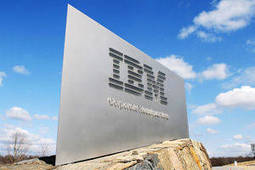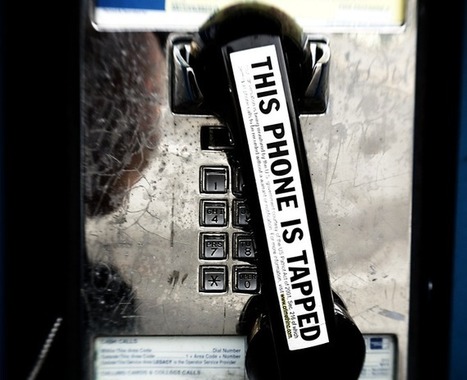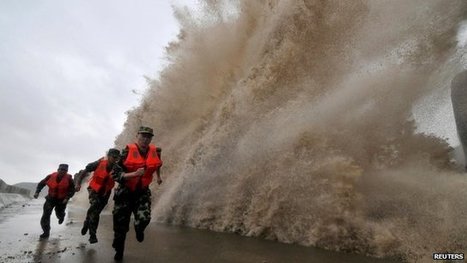 Your new post is loading...
 Your new post is loading...
Mobile broadband over smartphones and tablets has become the fastest growing segment of the global ICT market, according to ITU's flagship annual report Measuring the Information Society 2013.
New figures released today show buoyant global demand for information and communication technology (ICT) products and services, steadily declining prices for both cellular and broadband services, and unprecedented growth in 3G uptake.
By end 2013 there will be 6.8 billion total mobile-cellular subscriptions - almost as many as there are people on the planet.
An estimated 2.7 billion people will also be connected to the Internet - though speeds and prices vary widely, both across and within regions.
Mobile broadband connections over 3G and 3G networks are growing at an average annual rate of 40 per cent, equating to 2.1 billion mobile-broadband subscriptions and a global penetration rate of almost 30 per cent. Almost 50 per cent of all people worldwide are now covered by a 3G network.
Click headline to read more and access hot link to download report--
After the FBI executed an arrest warrant last week on Ross Ulbricht, the alleged mastermind behind the massive online drug marketplace Silk Road, it seized about 26,000 Bitcoins, worth roughly $3.2 million, that were stored in the site's user accounts.
However, Forbes reports that the FBI has yet to decrypt Ulbricht’s personal Bitcoin stash, which reportedly dwarfs the Silk Road accounts – about 600,000 Bitcoins, worth roughly $80 million.
If the $80 million estimate that the FBI spokesperson provided to Forbes is accurate, it would mean Ulbricht controlled nearly 5% of all Bitcoins on the market.
Despite the encryption difficulties, the bureau still has control of Ulbricht’s Bitcoin wallet, meaning nobody can really access its contents. For as long as the FBI can’t crack the safe, the $80 million remains in limbo.
Click headline to read more--
In the wake of extreme weather events like Hurricane Sandy, we need our state utilities to do more to protect against the impact of future storms. We need a plan that improves resiliency through energy efficiency and renewable energy. Updating utility infrastructure is needed, but it must be done responsibly. Demand response and efficiency are key to making our grid more resilient against future storms and to complement grid-hardening efforts.
Public Service Electric & Gas is requesting $3.9 billion for improvements to the grid over the next 10 years as part of its Energy Strong program. The money would go toward projects such as relocating switching stations and replacing low-pressure gas lines in flood areas. We believe that is not enough. We need energy efficiency, renewables, distributive generation and “smart grid” technology to update the grid. Without it, we are energy weak.
It is not enough to be energy strong. We have to be smarter and better. This rate case is too important for the future of New Jersey’s economy and energy supply. This plan ignores climate change, and we could be wasting almost $4 billion in ratepayer money. We can fix our electrical supply system to move us into the future.
Last month, the U.S. Department of Housing and Urban Development released its Hurricane Sandy Rebuilding Task Force Strategy Document, which outlines criteria for federal funding. On energy, HUD is calling for not just hardening the grid, but also making it more resilient through distributive generation, microgrid, combined heat and power, smart grid, renewable energy and energy efficiency. Utilities in New Jersey, including PSE&G, should be meeting these criteria. Otherwise, we could jeopardize future federal funding. PSE&G has not applied for the available HUD Community Development Block Grant funding or available Federal Emergency Management Agency funding for hardening projects. In New York, utilities are requesting that funding.
PSE&G has asked for a 10.3 percent rate of return as part of the rate case. It is not proposing to use its own money through bonding, borrowing or taking from stockholders. Instead, it is asking to use ratepayer money with a guaranteed $400 million in profit. The only other person guaranteed a 10 percent return was Bernie Madoff.
The utilities always want to do improvements on the backs of the ratepayers instead of looking at other sources. If federal money was secured, it would allow for greater investment in energy efficiency, conservation, smart grid and demand response that would make us even more resilient.
The Sierra Club is taking an active role in the Energy Strong case to support the use and further development of distributed generation, increasing the use of demand-side management technologies, implementation of smart grid networks, and other energy-efficiency programs.
Investing in energy efficiency will not only save energy resources but also save money and better prepare us for the next storm. Energy efficiency can reduce the need for new and expensive transmission lines, substations and other distribution infrastructure, making the grid less vulnerable to falling trees and flooding. This would save ratepayer money and have less of an environmental impact on sensitive features such as wetlands and streams.
Smart grid and distributed generation technology make the grid less vulnerable to circuit outages. This makes it easier to move energy sources around. Distributed generation can be tied to energy storage systems such as battery backup systems and renewable systems.
Clean energy mitigates the impacts of future storms by reducing carbon pollution in our atmosphere, lessening the future impacts of climate change.
Click headline to read more--
Over the summer there was a lot of digging going on in the Lancashire countryside.
Nothing unusual there you may think until you realise that these trenches are being built to house a fibre optic network with speeds to rival those that Google is installing in Kansas City.
The community-led Broadband 4 Rural North (B4RN) scheme offers speeds of up to 1Gbps (gigabit per second) to communities along its route.
And as it expands its network, more villages are asking if they can be connected too, proving that if you build it, they will come.
The project has hit problems - some minor, like a delay over the summer caused by some nesting lapwings, but some bigger, for example when Network Rail refused permission for the ducts to run over a bridge, forcing it to reroute in a river.
However its biggest problem is money. Despite raising £300,000 worth of local investment, the team behind the project estimate that the total cost will be £1.86m.
It applied for a government grant but is still waiting to hear whether it will qualify while it is also finding it tricky to get a loan.
It illustrates the difficulty of getting even a small-scale broadband network up and running and also begs the questions - why would farmers digging the trenches even want to take on such a project?
The reality is that they and other local residents are fed up with slow or non-existent broadband.
Commercial broadband providers like BT see no profit in rolling out complicated networks to a handful of houses in the middle of nowhere.
And that is rather galling for the people living in such communities who need broadband just as much, in some cases more, than their urban counterparts.
Broadband is now widely acknowledged as the fourth utility, and the government is all too aware that it needs to close the digital divide between town and country.
Click headline to read more--
New York City's largest buildings have as outsized a place in the city's energy use profile as they do in the skyline. Just two percent of New York's properties account for 48 percent of the city's energy use.
What's a city to do? The Bloomberg administration is doing what it does best: crunching massive amounts of data. On Wednesday, the mayor released the city's second annual benchmarking report [PDF], which analyzes the year-to-year energy and water use of New York's 26,680 largest buildings.
"It's the first time we've had access to this comparative information," says Melissa Wright, an associate director of the Natural Resources Defense Council’s City Energy Project who has worked in the Bloomberg administration. "For so long it was this hidden information about what the real energy performance was of a set of buildings or individual buildings."
Since this is only the second comprehensive report, conclusions on year-to-year progress are tentative. But there's still a tremendous amount of never-before-seen information about energy use in New York's buildings, which account for 74 percent of the city's greenhouse gas emissions:
Click headline to read more--
Every year, Freedom House publishes a report on the world's most and least digitally repressive countries. The worst offenders haven't improved much according to the latest edition of the report, out Thursday. But other countries experienced some striking changes over the past year.
Freedom House's index runs from 0 to 100, with 0 meaning "completely free" and 100 implying the opposite. Burma improved by 13 points, rising from a rank of 75 to 62. The country, also known as Myanmar, has gotten markedly more open in the wake of recent political reforms, spurring hopes for greater transparency and ease of access to credible information.
Broad swaths of the Middle East remain significantly unfree, with Iran and Syria leading that list. However, Tehran has recently made multiple promises to relax restrictions on the Web. The United States, meanwhile, dropped five points in the wake of this year's revelations about NSA surveillance. The only country to see its ranking fall even further was India, which dropped eight points in the netfreedom index.
Click headline to read more--
GE announced new technology for its utility customers running gas turbines on Thursday, but the bigger news might have been the technology that’s powering them. The new products are part of GE’s broader Predictivity lineup that analyzes data from the company’s large installed turbine base to help the machines and their operators work better.
Here’s how the company quantifies the promise of smarter turbines:
“In September 2013, GE eclipsed 100 million hours of operational data documented on its globally monitored gas turbine fleet of more than 1,600 units, the world’s largest. The insights derived from analysis of this operational “big data” can be applied to help customers expand their earning power while reducing operational costs and risk. As these “intelligent” machines communicate their operating statistics through an average of 100 physical sensors and 300 virtual sensors on each gas turbine, the GE team can help customers translate that information into actionable decisions. …
“… Unlocking the full capacity of a 500-MW power plant could be worth more than $500,000 annually in increased revenue, while a public utility that could reduce its heat rate efficiency curve by 1 percent could save up to $1.25 million dollars annually in fuel costs.”
Click headline to read more--
A US appeals court upheld a district court decision that Google's collection of data from unencrypted Wi-Fi networks under its Street View program is not exempt from federal wiretap laws.
Google's data collection does not qualify for the exemption as data transmitted over a Wi-Fi network is not an electronic communication that is readily accessible to the general public, the US Court of Appeals for the Ninth Circuit ruled Tuesday, giving a go-ahead to a privacy lawsuit against Google. Google had previously lost a similar action in Germany, where it was fined €140,000. In Ireland, the Officer of the Data Protection Commissioner opted for a less punitive approach, ordering Google to destroy any information collected over unsecured networks.
The Internet giant had argued that its data collection did not violate the Wiretap Act because it fell under an exemption that makes it lawful to intercept electronic communications that are readily accessible to the general public. The three-judge panel held that Wi-Fi network data collected by Google was not a radio communication, which is by definition readily accessible to the general public so long as it is not scrambled or encrypted.
Wi-Fi transmissions are not readily accessible to the general public because most of the general public lacks the expertise to intercept and decode payload data transmitted over a Wi-Fi network, Judge Jay S. Bybee wrote in the opinion. "Even if it is commonplace for members of the general public to connect to a neighbor's unencrypted Wi-Fi network, members of the general public do not typically mistakenly intercept, store, and decode data transmitted by other devices on the network."
Click headline to read more--
Russia is one of those countries that is pursuing nuclear power full tilt.
To help increase nuclear’s share electricity, it’s deploying novel ideas.
The most recent example: Over the last week, it has lowered two small reactors onto a ship berthed in St. Petersburg, which will eventually serve as a floating nuclear power station, World Nuclear News reported.
The milestone follows about four years of testing of the reactors on land, and puts the project back on pace following delays related to an earlier bankruptcy at the shipyard, which now seems to be sorted out.
Sergey Zavyalov, deputy general director of Rosenergoatom, the state-owned company that will operate the reactors, said he has “strong confidence the floating unit will be ready in time.” Rosenergoatom is ultimately part of Russia’s Rosatom national atomic agency.
The floating plant is due off the coast of the Chukotka Peninsula in northeast Russia in 2016, in a part of the Arctic Ocean known as the East Siberian Sea. The Chutkotka Peninsula has a mining industry.
Nuclear power will generate as much as half of Russia’s electricity by 2050, and up to 80 percent by the end of the century, according to the World Nuclear Association. The country will increasingly rely on a type of reactor known as a “fast reactor.”
Click headline to read more--
We've written several posts about a growing awareness of the dangers of investor-state dispute settlement (ISDS), which lets foreign companies sue entire countries for the alleged loss of future profits. One of the most egregious examples of ISDS concerns Canada, which is being sued by Eli Lilly & Co for $500 million after refusing to grant it a couple of pharma patents. Now The Huffington Post has details about another ISDS case involving Canada:
Free trade critics say a $250-million damage suit being pursued as a result of Quebec's moratorium on fracking is proof Canada needs to be careful in negotiating trade pacts around the world.
That's because TPP and TAFTA/TTIP, as well as Canada's bilateral treaty with Europe, CETA, all have ISDS clauses in them -- at least as far we know, given the obsessive secrecy that surrounds their negotiation. Here's the key issue in this latest case involving Canada:
"Quebec has yet to decide whether fracking -- a process to inject fluid into the ground at a high pressure in order to fracture shale rocks to release natural gas inside -- can be conducted safely under the St. Lawrence.
"If a government is not even allowed to take a time out to study the impact without having to compensate a corporation, it puts a tremendous chill on a governments' ability to regulate in the public interest," said Ilana Solomon, director of the Sierra Club's trade program in Washington, D.C."
That is, the company concerned is trying to pressure Quebec to lift its moratorium before the latter has had a chance to evaluate all the scientific evidence on fracking, and come to a reasoned decision. That seems to be a typical effect where ISDS clauses are in operation: with the threat of huge claims hanging over them, governments often choose to capitulate and give companies what they want, rather than risk losing before the secretive tribunals that are used to adjudicate such ISDS cases.
Click headline to read more--
Technology major IBM said it has been selected by Tata Power Delhi Distribution, a joint venture between Tata Power and Delhi government, to design and deliver smart grid solutions to better manage energy output and cut down outages.
"As a part of its smart grid initiative, Tata Power Delhi Distribution will collaborate with IBM to develop an advanced metering infrastructure and demand response pilot programme that will automate and regulate supply of electricity to consumers in sync with the fluctuating demand," IBM said in a release.
The project will help add a layer of digital intelligence to the grid and ensure reliability when there is an exponential rise in demand and the supply falls due to heavy consumption, it added.
Besides, this will provide customer service improvements including new digital meters, enhanced self-service options and access to a customer portal to manage energy use, it said.
The solution will also help empower the over 1.3 million electric consumers of Tata Power Delhi Distribution to manage their energy usage, it added.
Aggregated technical and commercial losses that occur due to electricity transmission and energy theft are estimated at about 26.4 per cent on a national average in India.
Click headline to read more--
The Dutch are known for their ingenuity in taming it and using it to their advantage, but their systems for keeping water at bay are now being rethought by architect Koen Olthuis and his team at Waterstudio. While rising sea and river levels have inspired governments around the world to invest in better flood defenses, with the Citadel, Olthuis is embracing water-borne housing with particular vigor.
Designed for developer ONW/BNG GO, The Citadel is a flotilla of apartments in one modern luxury development. The project, which will begin building work early next year, will consist of 60 units in a high density arrangement (30 units per acre of water). Part of the project means halting some flood defenses and letting the water back in. Olthuis points out that Holland has as many as 3,500 polders (patches of low-lying land that are protected by artificial dikes) which are below sea level and kept dry by pumping water out 24/7. This new development, dubbed New Water, will essentially be re-flooded after centuries of being kept artificially dry.
Lightweight construction on top of a main deck and easy connections to land are part of the program designed to deliver the same level of comfort as in a high-rise building. A large, heavy, floating concrete caisson provides the foundation, which also contains the car park, and will support the apartments. These will consist of 180 modular elements, all arranged around a central courtyard.
Click headline to read more--
Two years ago, Democratic Senators Charles Schumer and Joe Manchin sent a message to Attorney General Eric Holder and the head of the Drug Enforcement Agency: Shut down the Silk Road, they said.
Concerned by reports about a wide-open marketplace operating as a kind of stoner’s Amazon, the two senators demanded action. The Silk Road kept chugging along, but the senators’ June 8, 2011 letter had an immediate effect somewhere else: in the world of Bitcoin, the digital currency that helps drive the Silk Road.
Bitcoin prices promptly went over a cliff, dropping by two-thirds over the next three days. And they kept drifting downwards for months after that. The plunge seemed to confirm that the fates of the Silk Road and Bitcoin were intertwined.
Nobody really knew how big a part of the Bitcoin economy the Silk Road really played. But then the feds shuttered the Silk Road this past Wednesday, and now it’s pretty clear, thanks to the Federal Bureau of Investigation’s Christopher Tarbell, the special agent who signed the complaint against alleged Silk Road mastermind, Ross Ulbricht.
From February 2011 to July 2013, there were 1.2 million transactions on the site, accounting for 9.5 million bitcoins. That’s about 4 percent of the 225 million bitcoin transactions that happened on Bitcoin’s public block chain over the same period. The marketplace connected about 150,000 buyer accounts with just under 4,000 sellers.
That means that the Silk Road was a very big player in the Bitcoin world, but maybe not the giant that some suspected it was.
The relationship between Bitcoin and Ulbricht is clearer too, thanks to court documents that depict Ulbricht as a fan of Austrian Economic Theory and serious Bitcoin trader. According to prosecutors, Ulbricht was “Altoid,’ a frequent poster to Bitcoin forums. Altoid often boasted about buying low and selling high in Bitcoin exchanges. And when Silk Road launched, bitcoin was its only method of payment.
Since that time, legitimate bitcoin use has grown, and the bitcoin economy has diversified. There’s still a lot of gambling and speculation. But now you can buy groceries or electronics or cupcakes, or even pay for a cab with bitcoins
Click headline to read more--
|
As Edward Snowden’s leaks have revealed, none of our digital devices are truly safe from prying eyes, including Skype. As of February 2011, the U.S. government has had the capacity to monitor Skype calls and in July of this year, several newspapers exposed the level of cooperation Skype has had with the government in monitoring calls; the NSA apparently tripled its level of monitoring since July of last year, nine months after Microsoft bought the application.
There is now a Skype alternative called OStel, or Open Secure Telephony, offered by the Guardian Project, an organization that creates secure, open-source communications software that often assists those living under censorship. The site offers a very simple set-up on its website, including a simple registration, download and test call.
Nathan Freitas, who works at the Guardian Project, explains that OStel is not an app, per say, but a secure voice and video communication service that works on desktops and mobile devices alike. “We run the servers, but we do not ship any end-user software, in this case,” wrote Freitas in an e-mail. “The best way to think of [OStel] is as like running an IMAP/POP email service, where the user can use Thunderbird, Mac Mail, Outlook, etc, except instead of email, OStel provides real-time communications.”
The Guardian Project created OStel two years ago but only launched it last year as an open beta on Ostel.co but its popularity has apparently grown recently.
Click headline to read more--
Appliance makers have been putting together "Homes of Tomorrow" ever since they realized that electricity was more than a passing fad. Over the decades, Frigidaire, Westinghouse, General Electric and many others have pulled out the crystal ball to gaze into our domestic future. Now GE is jumping forward to the year 2025 to show us what home life will be like in the middle of the next decade.
Back in 1950, GE unveiled its vision of the 21st century kitchen complete with pop-up fridge, ice dispenser, plastic plate maker, and ultrasonic dishwasher. This time around, the company is only hopping forward 12 years and is trying to keep its engineering feet on the ground.
"This isn't about the Jetsons or pie-in-the-sky ideas," says Lou Lenzi, director for GE Appliances’ Industrial Design Operation. "Home 2025 is about reality-based innovation that will be possible over the next decade."
GE says this "reality-based innovation" goes beyond looking at the technological possibilities, but also what would fit the lifestyles of 2025. The designers took into account food science, demographic projections, healthcare, environmental concerns and water scarcity. For good measure, they also made some assumptions about the future economy and commerce.
Click headline to read more, view pix and watch video--
Powerful Typhoon Fitow has rammed into eastern China after triggering the evacuation of hundreds of thousands of people.
With winds up to 151km/h (93mph), the storm landed in Fujian province early on Monday, bringing heavy rains and causing widespread power cuts.
The authorities earlier issued the highest alert - red - for the area.
At least two people have been killed by the typhoon, state-run news agency Xinhua reported.
One victim was on his way to rescue a fisherman when he was blown off a hill by strong winds late on Sunday, Xinhua said.
Some homes are said to have collapsed in neighbouring Zhejiang province and two port workers are missing.
Typhoon Fitow - named after a flower - made landfall at 01:15 local time on Monday (17:15 GMT Sunday) in the city of Fuding, Chinese meteorologists said.
The typhoon had affected over three million people in Zhejiang and caused economic damage of over 2bn yuan ($330m; £200m), Xinhua said, citing the provincial flood control office.
Parts of China have been hit by up to 200mm (8 inches) of rain, AFP news agency reported.
Over the weekend the authorities drafted in the army to help strengthen flood defences, the BBC's John Sudworth in Shanghai reports.
China is used to dealing with extreme weather events but, nonetheless, the risk to life remains high, our correspondent adds.
Click headline to read more--
Researchers at the University of Alberta have developed a less complicated, less expensive way of manufacturing solar panels – and it could make getting off the power grid easier for residents.
The group has been studying solar power cells for several years. After more than 200 attempts, they’ve managed to create a liquid and use it to make films that can absorb light and conduct electricity.
“What these are are very tiny particles that we make in the lab that are made out of very abundant, very cheap materials,” explained U of A Nano Researcher Jillian Buriak.
The materials are zinc and phosphorus. Since they are common, it’s less expensive to make the panels than the specialty materials like cadmium which is currently used.
Panels made out of the liquid are also thinner and not as heavy. They would not need to be installed on roofs; instead the nano particle based liquid could be used to print solar cells using methods similar to a newspaper press. It could even be turned into a spray that could be coated on an object like a wall.
“They’re going to be very flexible and light so you can incorporate them into window blinds and you can make them aesthetically beautiful,” Buriak stated.
To create the nanoparticles, Buriak teamed up with Erik Luber from the University’s Faculty of Engineering, and Hosnay Mobarok of the Faculty of Science.
The goal is to make solar energy easy and accessible even in areas like Canada’s far north and remote areas around the world.
Click headline to read more and watch the CTV news clip--
Scientists in the US say they have found evidence suggesting that warmer sea surface temperatures may increase the ability of fish to accumulate mercury.
This could present a risk to the health of some consumers of seafood as the mercury rises up the marine food chain.
The scientists, based at Dartmouth College, New Hampshire, report their research in the journal PLOS ONE (Public Library of Science ONE).
Until now science has known little about how global warming may affect mercury accumulation in marine life, and this is the first study to show the effects using fish in both laboratory and field experiments.
The researchers studied Killifish, found in much of the world – but not in Australia, Antarctica or northern Europe – and living mainly in fresh or brackish water.
They studied the fish under varying temperatures in the lab and in salt marsh pools in Maine. Fish in the marshes ate insects, worms and other natural food sources, while the lab fish were fed mercury-enriched food.
The results showed that fish in warmer water ate more but grew less and had higher methylmercury levels in their tissues, suggesting that increases in their metabolic rate caused the increased mercury uptake.
Mercury released into the air from industrial pollution can accumulate in streams and oceans and is turned into methylmercury in the water.
Click headline to read more--
The heart-breaking news from Fukushima just keeps getting worse…a LOT worse…it is, quite simply, an out-of-control flow of death and destruction. TEPCO is finally admitting that radiation has been leaking to the Pacific Ocean all along. and it’s NOT over…. I find myself moving between the emotions of sorrow and anger.
It now appears that anywhere from 300 to possibly over 450 tons of contaminated water that contains radioactive iodone, cesium, and strontium-89 and 90, is flooding into the Pacific Ocean from the Fukushima Daichi site everyday. To give you an idea of how bad that actually is, Japanese experts estimate Fukushima’s fallout at 20-30 times as high as as the Hiroshima and Nagasaki nuclear bombings in 1945
There’s a lot you’re not being told. Oh, the information is out there, but you have to dig pretty deep to find it, and you won’t find it on the corporate-owned evening news.
Click headline to read more--
In all, UPC is supplying 70 schools across Ireland with fibre broadband as part of the nationwide Schools Broadband Scheme.
Magnus Ternsjö, CEO, UPC Ireland, said: "UPC's fibre powered network allows us to provide superfast broadband speeds to these schools. We worked in partnership with HEAnet, Ireland's national education and research network, to provide this service so as to be available to meet the needs of today's students."
John Farrell, deputy principal, Bishopstown Community School, one of the schools to avail of UPC superfast broadband, said: "Our school community is focussed on the enablement of skills that will prepare our students for life and living in an increasingly rapidly evolving society. Access to technology and digital media is essential for social inclusion and future career prospects and it forms a key element of our total school curriculum. We are very pleased with the high quality broadband access that has now been provided for our school and we will use it to the maximum possible for the benefit of our students throughout our classrooms, technology rooms and science labs."
Click headline to read more--
The new report from the Intergovernmental Panel on Climate confirms what countless people in Latin America and the Caribbean already know – something is seriously wrong with the weather and it’s time we start doing something about it. The report released in Sweden today confirmed with 95% scientific certainty that human actions are behind the warming planet, melting ice and weather extremes we’re witnessing.
These impacts of climate change are already being felt acutely in Latin America and the IPCC’s latest report likely means the region should brace itself for more. Fortunately, by acting now to drastically reduce carbon pollution – from energy production, transportation, and deforestation –the very worst scenarios can still be avoided.
The new report, the first installment in a series of four documents, assesses the scientific evidence that our climate is changing. Across Latin America, people are already seeing changes first hand:
Click headline to read more--
Using two sets of satellite data, a team of scientists calculated how quickly Venice is sinking and how much of it can be blamed on nature, and how much on humans.
The scientists used radar imagery data collected by four different satellites and a relatively new analysis technique known as Persistent Scatterer Interferometry to make a much higher resolution calculation of the sinking than was previously possible. That might sound complicated, but the basic idea is actually pretty simple.
Two of the satellites are a bit older and produce somewhat lower resolution data, but they have been in orbit longer, so the data spans a longer period of time from 1992 to 2010. The other two satellites have higher-resolution data that only dates back to 2008. The scientists used the longer data set to find the average rate of sinking, which can be attributed to the natural sinking of Venice relative to sea level. This is caused by a combination of factors including deformation of the tectonic plate beneath Venice and compaction of the sediments under the city.
They then looked at the higher-resolution short-term data set and subtracted the average natural sinking. They argue that what was left, shown on the map in the first slide above, can be attributed to human activity such as reconstruction of historical buildings, restoration of canal edges and erosion along the canal banks by waves from the high volume of ship and boat traffic in the area.
They conclude that the average background sinking is around 1 millimeter per year. The more acute man-made sinking ranged up to 10 millimeters a year (shown in red on the map above on the first slide), but in some places human activity actually reduces the natural sinking (shown in green).
Click headline to read more--
Orange Poland has launched a new fiber to the home package that bundles 300Mbps broadband, 119 television channels, a Livebox 3.0 fiber-ready gateway, a whole-house DVR, and unlimited calling for $64.50 a month with a two-year contract.
The new service is now available to more than 14,000 homes in Warsaw and has gotten good reviews from about 1,000 beta test subscribers. Orange Poland says their fiber network is capable of faster Internet speeds, which it is considering introducing after the initial launch is complete.
Click headline to read more--
Most students are happy to graduate college with a degree and a few work contacts, but students from The Netherlands' Delft University of Technology have a good shot at graduating with a world record. Just days after a group of Delft students grabbed the human powered speed record, another group set a world acceleration record for electric vehicles.
The team didn't just beat the standing record for 0-100 km/h (62 mph) in an electric car, but beat its own expectations handily. On September 20, the students hit the mark in 2.15 seconds, besting the previous time of 2.68 seconds by just over half a second. They used their self-built DUT12 race car to complete the feat.
"We thought that under these conditions we’d be happy with 2.30, but we really didn’t expect 2.15," says DUT Racing team manager Tim de Moree.
Expected or not, that 2.15-second time is quite impressive. Not only is it the fastest for an electric car, but it's faster than many a notable gas vehicle, including the Bugatti Veyron, which has long advertised a 2.5-second 0-62 mph time, and the 500-hp Ariel Atom V8, which lists in at 2.3 seconds.
DUT Racing built the DUT12 to compete in last year's Formula Student competition. The group's second electric car, the update from the DUT11 introduced a four-wheel drive system comprising four individual motors. The students were able to harness the full power of the motors for the record attempt, unlike in Formula Student racing where they had to cap it at 114 hp. By freeing up the full 135 hp output, the team moved closer to one horse per kilogram and shot out of the gate with emphasis.
Click headline to read more and view pix--
Nothing keeps the mosquitoes away quite as well as DEET, but it's not the most innocuous of substances – besides stinking, it also melts plastic and synthetic fabrics, plus it's even been linked to problems in users' central nervous systems. It can also be prohibitively expensive for use in developing nations. Thanks to research being conducted at the University of California, Riverside, however, a new generation of non-toxic but highly-effective repellants may be on its way.
Previously, scientists had known that insects avoided DEET, but they didn't know which olfactory receptors the animals used to detect it. As a result, it was difficult to develop alternative repellants, as no one knew exactly what they should be targeting.
A UC Riverside team led by Prof. Anandasankar Ray, however, has located those receptors. They did so by examining genetically-engineered fruit flies, in which any neurons that were activated by DEET would fluoresce green. It turns out that the receptors are located on part of the antenna known as the sacculus.
Click headline to read more--
|



 Your new post is loading...
Your new post is loading...





























